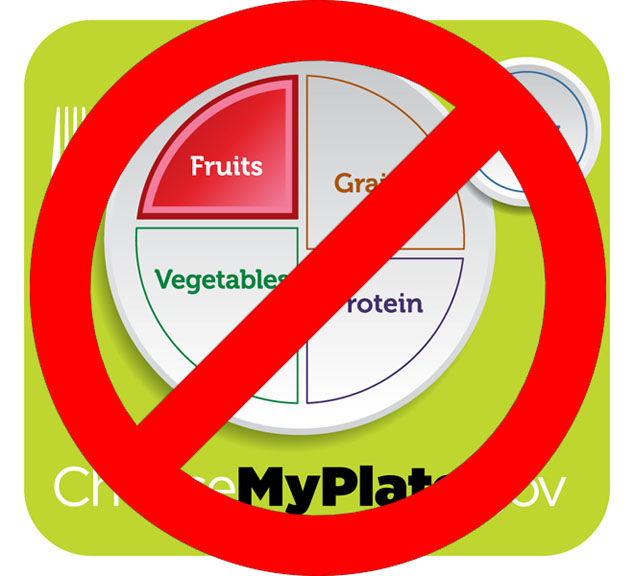 First off, eating right means you must ignore most dietary advice by the USDA, FDA, AMA, AHA, and any other similarly clueless government or professional medical organization. Protein and fat are the healthiest foods. There is no such thing as a carbohydrate deficiency, since we do not need dietary carbohydrates whatsoever. Here is what a day of eating right actually looks like.
First off, eating right means you must ignore most dietary advice by the USDA, FDA, AMA, AHA, and any other similarly clueless government or professional medical organization. Protein and fat are the healthiest foods. There is no such thing as a carbohydrate deficiency, since we do not need dietary carbohydrates whatsoever. Here is what a day of eating right actually looks like.
Perspective on Eating Right
Before peeking at what is good to do, first be aware that you are undoubtedly inundated by bad advice from health care professionals of all stripes. Pay no attention to it.
One more thing, if you are diabetic you can include the American Diabetic Association in the above list of agencies. This earlier post explains why: Doctors Give Amazingly Bad Advice for Diabetics – and Everyone Else.
Ignore the Loud Voices
Myths about good eating are perpetuated by the ‘loud voices’ of health. Loudness correlates with financial backing and moneyed interests, plus some fuzzy-thinking scientists who add nonsense to the mix. This din rests on a body of medical research that is, at best, shoddy. I don’t want to focus on all the health crap that is stuffed down the public’s throat (pardon the pun), so I will just refer you to the work of Dr. John Ioannidis, who has made a career out of exposing bad medical science. The details of what he has found were highlighted in a feature article in the October 4th, 2010, issue of Atlantic magazine, the text of which is available for download here: Lies, Damned Lies, and Medical Science.
The point is that if anything this post says about eating right scares you, then you are suffering from a medical myth. I will leave it at that for the moment.
Now let’s get down to what a day of good eating looks like.
Eating Patterns
Meal frequency is the most important factor for good eating. It is much, much more important than how much you eat. In fact, if you eat too often, you will have absolutely no chance of maintaining any kind of good health. The ‘eat six small meals a day’ crowd is NOT your friend. That advice is idiotic based on what that pattern does to disrupt your daily hormone cascade, starting with leptin and insulin and continuing through growth hormone and many more.
How much you eat is unimportant, if you space your meals appropriately. Indeed, calorie counting is such a simple-minded irrelevance that you can just skip any thoughts about it completely. I got so fed up with this myth that I put together a short explanatory book that you can download at no charge here: Calorie Counting Madness: Surprising Truths About Weight Loss. Of course, if you want to actually PAY for it, you can get the Kindle edition on Amazon for a whopping 99 cents, here.
Meal spacing is also more important than food group portions, although that varies depending on whether you are leptin sensitive (normal) or leptin resistant (i.e., unacceptably overweight or obese). If you are leptin resistant, almost nothing will work for you for losing weight and getting healthy until you overcome it. In such case, carbohydrates will undermine everything you want to accomplish. Your best bet is to consume a ketogenic diet (fewer than 20 grams of carbs per day … which is very little).
Let me reiterate:
YOU MUST REVERSE LEPTIN RESISTANCE IF YOU WANT TO BE HEALTHY.
If you are not sure whether you are leptin resistant, or you don’t know the details of how to overcome it if you are, take a look at the best advice that I have ever found, by Dr. Jack Kruse, here: Leptin Reset Easy Start Guide. Follow it to the letter as much as you can and you will be shocked by the changes in your own body. Shocked, I tell you!
My Eating Patterns
First off, I am already sufficiently leptin sensitive for getting optimal results from my eating pattern. At one time I was leptin resistant, weighing in at 210 lbs. That was my limit before I took appropriate action. Now my weight hangs around 185 lbs.
With that in mind, a good eating day for me starts out with what Dr. Kruse calls a ‘Big-Ass Breakfast’ (BAB). An example would be what I ate this morning, not too long after rising. It consisted of the following:
- Can of sardines (3.5 oz) (in extra virgin olive oil)
- Leftovers from last night’s fajita dish (beef brisket with red bell peppers) … probably another 6 ounces; with added guacamole and picante sauce for flavor
- Three jumbo eggs, scrambled together with the fajita dish in about 4 tbsp of coconut oil
Before breakfast I woke up to a couple of cups of bulletproof coffee (i.e., a tbsp of butter in each cup), followed by a cup of coffee with a tbsp of coconut oil.
As you can see this BAB was high-protein and high-fat. That is the type of meal that helps me maintain at least a low level of ketosis at all times. My body runs better on ketones, and so does yours. Actually, everyone’s does.
My only weakness was having about an ounce of dark chocolate after breakfast. Just for sanity, I suppose. More fat, too.
On a day like today, with that kind of BAB, I can skip eating anything else until dinner. A good BAB, with sufficient protein, will stave of any hunger for 7-9 hours, which is my goal.
This gives me a fasting period of 7-9 hours on the days that start with a BAB.
On other days, usually Sundays and Thursdays around my household, I will fast all day, until dinner. This gives me two twice-a-week fasting days of about 24 hours. Researchers call this Intermittent Fasting, which provides numerous health benefits. See my overview of this topic in a previous article here: Health Problems Reversed by Intermittent Fasting.
Either way, with or without a BAB, I always have dinner before 7:00 PM and have no snacks whatsoever during the evening. This provides the minimum of a dinner-to-breakfast fasting period of 12-14 hours, which is crucial for proper nighttime metabolism and hormone signaling.
About Food
As I mentioned, I shoot to stay in mild ketosis as much as possible. This means seeing at least a ‘Trace’ reading on the Ketostix Reagent Strips that I get at my local pharmacy. My readings usually vary between ‘Trace’ and ‘Moderate’ (i.e., 5-40 mg/dL).
The type of foods that drive this result are very low in carbohydrates and very high in fats and proteins. Sources for the latter entail mostly animal meats, although I do include a substantial (8 tbsp or more) amount of coconut oil on most days. I exclude cereal grains, legumes, and most dairy. Dinners often include something green and usually leafy, the darker green the better.
This food selection looks like a Paleo diet, which is partially correct. The main difference is that my animal proteins do not focus on skeletal (muscle) meats. Advice to eat such meats is a major flaw in the Paleosphere. See what that means in this earlier article: Will the Real Paleo Diet Please Stand Up?
Early in 2015 I discovered some answers to a puzzle about good dietary fats. Dietary advice about what good fats are seems to be all over the map. One thing has become abundantly clear: good eating has to include a sufficient amount of saturated fats and cholesterol. This is absolutely crucial. Remember, if this scares you, then you are still swallowing medical myths about diet.
Further clarity about dietary fats came by understanding the huge value of DHA, a fatty acid that we typically get from fish oil. There is no way to overstate the importance of DHA. Once I began to grasp its role in my health, I started consuming fish almost every day – fish with the highest amounts of DHA.
DHA is the central topic regarding fish oils and fish oil supplements that I wrote about here: Fish Oils – Industry BS Just Plain Fishy. If you do not pay attention to getting more DHA, in the right biochemical form, into your diet after reading that article, then … well, good luck getting healthy.
You Up for Eating Right Now?
This is a brief summary of how good eating looks. Just for fun, be mindful of how you eat from now on and how it compares with the main points in this post. Then see what you can do to mimic what a day of good eating really is.
By the way, a quick heads up on the importance of good eating:
Diet is, of course, of benefit when you follow truly good advice. The same could be said for exercise, which is another topic about which you are certainly inundated with bad advice. The good news is that, if we could rank the impact of diet and exercise on health, they would be down the list in comparison with other factors. They may even be as low as third or fourth in importance.
Isn’t that a curious comment? It is going to take some time for me to explain what the most important factors actually are that influence your health in modern times. A series of upcoming articles will address them.
I don’t want to leave you on the edge of your seat completely, though. So I will simply state that they include electricity, magnetism, and water. Moreover, the biochemistry that I have always loved to talk about so much will be replaced with an area of science that is even more challenging: biophysics.
I am sure you can hardly wait.
Meanwhile, enjoy the benefits of good eating.
All the best in natural health,
Dr. D

Thanks for the information! Please include me in future posts!
Hi, Denise…Glad to do so. Just subscribe to my newsletter here: http://herbscientist.com/complete-nutrition/
You will then get all of my updates.
All the best,
Dennis
Hi Dr. Dennis, Great post! Very interesting and helpful. I always appreciate when people post from experience. Thanks for sharing.
Thanks again for you kind comments, Kristy. I hope the post helps others, too.
All the best,
Dennis